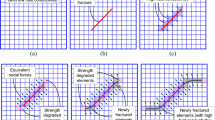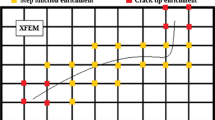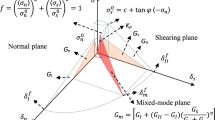Abstract
Near-wellbore fracture tortuosity has important impacts on the productivity of fractured oil and gas wells and the injectivity of CO2 or solids disposal injectors. Previous models for simulating near-wellbore fracture tortuosity usually assume fracture growth in linear-elastic media, without considering the effects of porous features of the rock. In this paper, a 2D fully coupled model is developed to simulate near-wellbore fracturing using the XFEM-based cohesive segment method. The model takes into account a variety of crucial physical aspects, including fracture extension and turning, fluid flow in the fracture, fluid leak-off through wellbore wall and fracture surfaces, pore fluid flow, and rock deformation. The proposed model was verified against two sets of published experimental results. Numerical examples were carried out to investigate the effects of various parameters on near-wellbore fracture trajectory, injection pressure, and fracture width. Results show that near-wellbore fracture behaviors are not only dependent on rock elastic properties and field stresses, but also greatly influenced by porous properties of the rock, such as permeability and leak-off coefficient. Some field implications were provided based on the simulation results. By overcoming some limitations of the previous models, the proposed model predicts more realistic fracture evolution in the near-wellbore region and provides an attractive tool for design and evaluation of many field operations, for which near-wellbore fracture behaviors play an important role on their successes.

























Similar content being viewed by others
References
Abass HH, Brumley JL, Venditto JJ (1994) Oriented perforations—a rock mechanics view. In: Presented at the SPE annual technical conference and exhibition
Abdollahipour A, Fatehi Marji M, Yarahmadi Bafghi A, Gholamnejad J (2015) Simulating the propagation of hydraulic fractures from a circular wellbore using the Displacement Discontinuity Method. Int J Rock Mech Min Sci 80:281–291
Al-Busaidi A, Hazzard JF, Young RP (2005) Distinct element modeling of hydraulically fractured Lac du Bonnet granite. J Geophys Res Solid Earth 110(B6):B06302
Areias P, Rabczuk T (2017) Steiner-point free edge cutting of tetrahedral meshes with applications in fracture. Finite Elem Anal Des 132:27–41
Areias P, Rabczuk T, Dias-da-Costa D (2013) Element-wise fracture algorithm based on rotation of edges. Eng Fract Mech 110:113–137
Areias P, Rabczuk T, Camanho PP (2014) Finite strain fracture of 2D problems with injected anisotropic softening elements. Theor Appl Fract Mech 72:50–63
Areias P, Msekh MA, Rabczuk T (2016) Damage and fracture algorithm using the screened Poisson equation and local remeshing. Eng Fract Mech 158:116–143
Behrmann LA, Nolte KG (1999) Perforating requirements for fracture stimulations. SPE Drill Complet 14(04):228–234
Bruno MS, Dorfmann A, Lao K, Honeger C (2001) Coupled particle and fluid flow modeling of fracture and slurry injection in weakly consolidated granular media. In: Presented at the DC Rocks 2001, the 38th U.S. symposium on rock mechanics (USRMS)
Camanho PP, Dávila CG (2002) Mixed-mode decohesion finite elements for the simulation of delamination in composite materials. NASA/TM-2002–211737, pp 1–37
Chen M, Jiang H, Zhang GQ, Jin Y (2010) The experimental investigation of fracture propagation behavior and fracture geometry in hydraulic fracturing through oriented perforations. Pet Sci Technol 28(13):1297–1306
Cherny S et al (2009) Two-dimensional modeling of the near-wellbore fracture tortuosity effect. Int J Rock Mech Min Sci 46(6):992–1000
Detournay E (2004) Propagation regimes of fluid-driven fractures in impermeable rocks. Int J Geomech 4(1):35–45
Fallahzadeh SH, Rasouli V, Sarmadivaleh M (2015) An investigation of hydraulic fracturing initiation and near-wellbore propagation from perforated boreholes in tight formations. Rock Mech Rock Eng 48(2):573–584
Feng Y, Gray KE (2016) A fracture-mechanics-based model for wellbore strengthening applications. J Nat Gas Sci Eng 29:392–400
Feng Y, Gray KE (2017) Modeling near-wellbore hydraulic fracture complexity using coupled pore pressure extended finite element method. In: Presented at the 51st U.S. rock mechanics/geomechanics symposium
Feng Y, Gray KE (2017) Modeling lost circulation through drilling-induced fractures. SPE J
Feng Y, Arlanoglu C, Podnos E, Becker E, Gray KE (2015) Finite-element studies of hoop-stress enhancement for wellbore strengthening. SPE Drill Complet 30(01):38–51
Garagash DI (2006) Propagation of a plane-strain hydraulic fracture with a fluid lag: early-time solution. Int J Solids Struct 43(18):5811–5835
Gordeliy E, Abbas S, Prioul R (2016) Modeling of near-wellbore fracture reorientation using a fluid-coupled 2D XFEM algorithm. In: Presented at the 50th U.S. rock mechanics/geomechanics symposium
Haddad M, Sepehrnoori K (2015) Simulation of hydraulic fracturing in quasi-brittle shale formations using characterized cohesive layer: stimulation controlling factors. J Unconv Oil Gas Resour 9:65–83
Jeffrey RG, Zhang X (2010) Mechanics of hydraulic fracture growth from a borehole. In: Presented at the Canadian unconventional resources and international petroleum conference
Li Y, Deng JG, Liu W, Feng Y (2017) Modeling hydraulic fracture propagation using cohesive zone model equipped with frictional contact capability. Comput Geotech 91:58–70
Liu F, Gordon PA, Valiveti DM (2017) Modeling competing hydraulic fracture propagation with the extended finite element method. Acta Geotech. https://doi.org/10.1007/s11440-017-0569-6
McClure MW, Horne RN (2014) An investigation of stimulation mechanisms in Enhanced Geothermal Systems. Int J Rock Mech Min Sci 72:242–260
Moës N, Dolbow J, Belytschko T (1999) A finite element method for crack growth without remeshing. Int J Numer. Methods Eng 46(1):131–150
Mogilevskaya SG, Rothenburg L, Dusseault MB (2000) Growth of pressure-induced fractures in the vicinity of a wellbore. Int J Fract 104(4):23–30
Nguyen VP, Lian H, Rabczuk T, Bordas S (2017) Modelling hydraulic fractures in porous media using flow cohesive interface elements. Eng Geol 225:68–82
Rabczuk T, Belytschko T (2004) Cracking particles: a simplified meshfree method for arbitrary evolving cracks. Int J Numer Methods Eng 61(13):2316–2343
Rabczuk T, Belytschko T (2007) A three-dimensional large deformation meshfree method for arbitrary evolving cracks. Comput Methods Appl Mech Eng 196(29):2777–2799
Rabczuk T, Song J-H, Belytschko T (2009) Simulations of instability in dynamic fracture by the cracking particles method. Eng Fract Mech 76(6):730–741
Rabczuk T, Zi G, Bordas S, Nguyen-Xuan H (2010) A simple and robust three-dimensional cracking-particle method without enrichment. Comput Methods Appl Mech Eng 199(37):2437–2455
Remmers JJC, de Borst R, Needleman A (2008) The simulation of dynamic crack propagation using the cohesive segments method. J Mech Phys Solids 56(1):70–92
Ren H, Zhuang X, Cai Y, Rabczuk T (2016) Dual-horizon peridynamics. Int J Numer Methods Eng 108(12):1451–1476
Renc H, Zhuangd X, Rabczuk T (2017) Dual-horizon peridynamics: a stable solution to varying horizons. Comput Methods Appl Mech Eng 318:762–782
Sepehri J, Soliman MY, Morse SM (2015) Application of extended finite element method to simulate hydraulic fracture propagation from oriented perforations. In: Presented at the SPE hydraulic fracturing technology conference
Silling SA (2000) Reformulation of elasticity theory for discontinuities and long-range forces. J Mech Phys Solids 48(1):175–209
Simulia DS (2016) Abaqus analysis user's manual. Dassault Systemes, Providence
Snow DT (1969) Anisotropie permeability of fractured media. Water Resour Res 5(6):1273–1289
Song J-H, Areias PMA, Belytschko T (2006) A method for dynamic crack and shear band propagation with phantom nodes. Int J Numer Methods Eng 67(6):868–893
Terzaghi K (1943) Theory of consolidation. In: Theoretical soil mechanics. Wiley, New York 1943, pp 265–296
Turon A, Camanho PP, Costa J, Dávila CG (2006) A damage model for the simulation of delamination in advanced composites under variable-mode loading. Mech Mater 38(11):1072–1089
Vermeer PA, Verruijt A (1981) An accuracy condition for consolidation by finite elements. Int J Numer Anal Methods Geomech 5(1):1–14
Wang T, Liu Z, Zeng Q, Gao Y, Zhuang Z (2017) XFEM modeling of hydraulic fracture in porous rocks with natural fractures. Sci China Phys Mech Astron 60(8):084612
Weng X (1993) Fracture initiation and propagation from deviated wellbores. In: Presented at the SPE annual technical conference and exhibition
Wu K, Olson JE (2016) Mechanisms of simultaneous hydraulic-fracture propagation from multiple perforation clusters in horizontal wells. SPE J 21(03):1000–1008
Wu K, Olson J, Balhoff MT, Yu W (2017) Numerical analysis for promoting uniform development of simultaneous multiple-fracture propagation in horizontal wells. SPE Prod Oper 32(01):41–50
Yao Y (2012) Linear elastic and cohesive fracture analysis to model hydraulic fracture in brittle and ductile rocks. Rock Mech Rock Eng 45(3):375–387
Zhang X, Jeffrey RG, Thiercelin M (2007) Deflection and propagation of fluid-driven fractures at frictional bedding interfaces: a numerical investigation. J Struct Geol 29(3):396–410
Zhang GM, Liu H, Zhang J, Wu HA, Wang XX (2010) Three-dimensional finite element simulation and parametric study for horizontal well hydraulic fracture. J Pet Sci Eng 72(3–4):310–317
Zhang X, Jeffrey RG, Bunger AP, Thiercelin M (2011) Initiation and growth of a hydraulic fracture from a circular wellbore. Int J Rock Mech Min Sci 48(6):984–995
Zhang X, Jeffrey RG, Bunger AP (2011) Hydraulic fracture growth from a non-circular wellbore. In: Presented at the 45th U.S. rock mechanics/geomechanics symposium
Zhao P, Santana CL, Feng Y, Gray KE (2017) Mitigating lost circulation: a numerical assessment of wellbore strengthening. J Pet Sci Eng 157:657–670
Zhou X, Burbey TJ (2014) Fluid effect on hydraulic fracture propagation behavior: a comparison between water and supercritical CO2-like fluid. Geofluids 14(2):174–188
Zhou J, Zhang L, Pan Z, Han Z (2016) Numerical investigation of fluid-driven near-borehole fracture propagation in laminated reservoir rock using PFC2D. J Nat Gas Sci Eng 36:719–733
Zhou J, Zhang L, Braun A, Han Z (2017) Investigation of processes of interaction between hydraulic and natural fractures by PFC modeling comparing against laboratory experiments and analytical models. Energies 10(7):1001
Zhu H, Guo J, Zhao X, Lu Q, Luo B, Feng Y-C (2014) Hydraulic fracture initiation pressure of anisotropic shale gas reservoirs. Geomech Eng 7(4):403–430
Acknowledgements
The authors wish to thank the Wider Windows Industrial Affiliate Program, the University of Texas at Austin, for financial and logistical support of this work. Program support from BHP Billiton, British Petroleum, Chevron, ConocoPhillips, Halliburton, Marathon, National Oilwell Varco, Occidental Oil and Gas, and Shell is gratefully acknowledged. Thanks are due also to Dr. Evgeny Podnos for his manuscript review and suggestions.
Author information
Authors and Affiliations
Corresponding author
Rights and permissions
About this article
Cite this article
Feng, Y., Gray, K.E. XFEM-based cohesive zone approach for modeling near-wellbore hydraulic fracture complexity. Acta Geotech. 14, 377–402 (2019). https://doi.org/10.1007/s11440-018-0645-6
Received:
Accepted:
Published:
Issue Date:
DOI: https://doi.org/10.1007/s11440-018-0645-6




